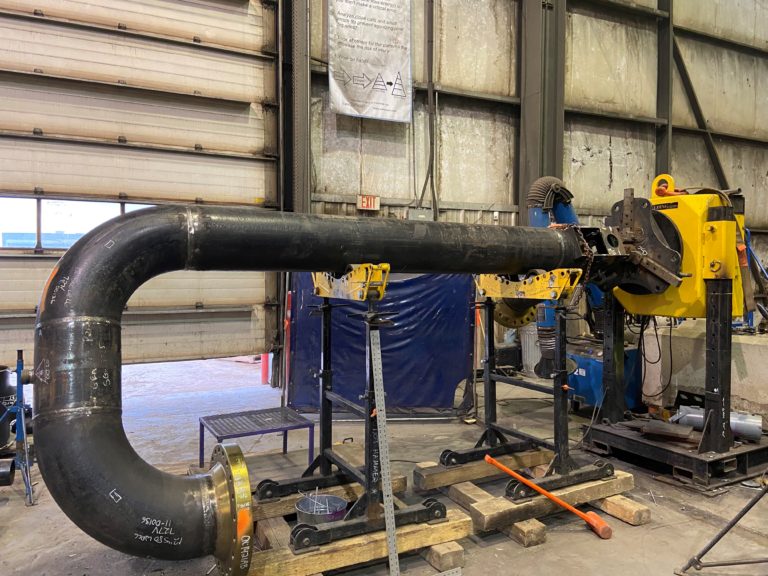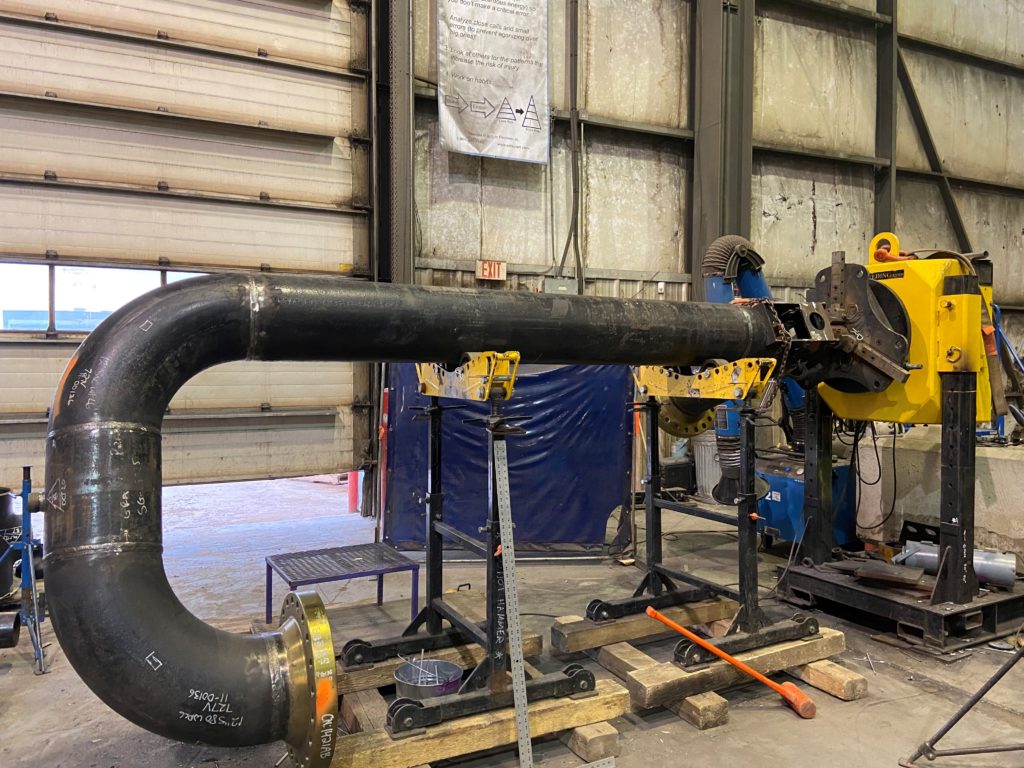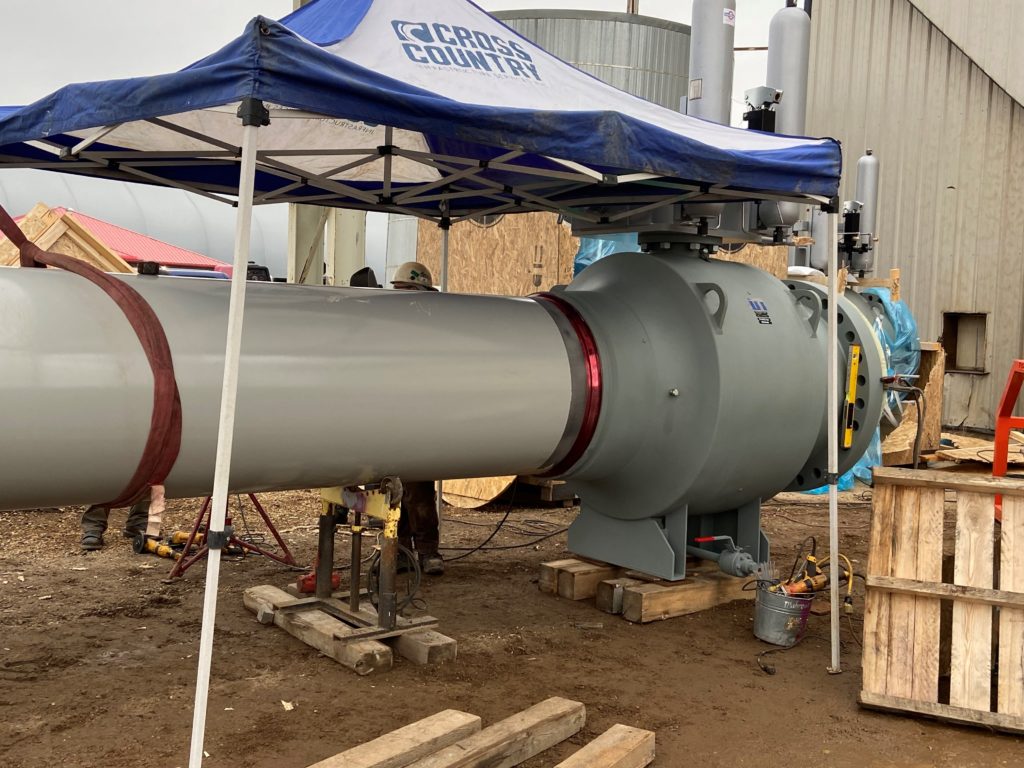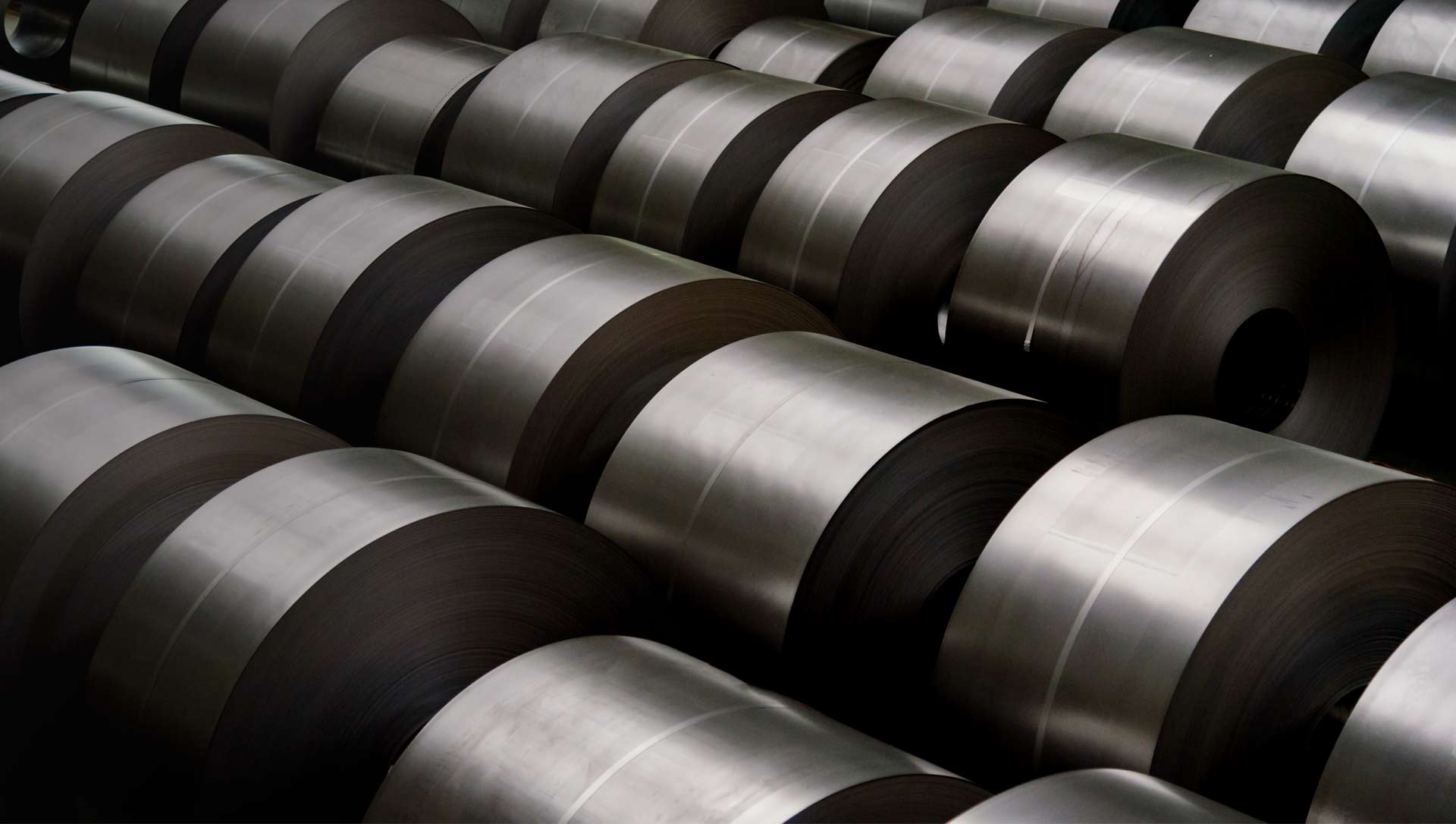Ideal Pipe Fabrication
Seemingly a simple process, pipe fabrication is a complex process requiring high precision and can involve thousands of components and hundreds of steps. Pipe fabrication is the process of creating a piping system which involves cutting, beveling, welding, and inspection of various piping components including pipe, tees, elbows, flanges, reducers, valves etc.
Ideal Coatings & Fabrication completes their pipe fabrication indoors in our shop providing a controlled environment for our shop by hand welders. Traceability of each component such as consumables (weld rod/wire), materials and the certifications of the worker preforming each task is critical in the process. Pipe fabricators in western Canada must have a registered Quality Management System (QMS) in order to fabricate piping systems.
Pipe fabrication is incredibly detailed from beginning to end, no matter the size or scope of the project. Prior to releasing a pipe fabrication project to a fabricator such as Ideal, considerable time is spent by the owner and engineer to design the piping system for specific requirements while complying with applicable codes and standards.

Pipe fabrication starts with the issuance of an “Issued for Construction (IFC)” drawing package from the owner/engineer. This package consists of the stamped engineered drawings, piping specifications, Approved Manufactures List (AML), and often a 3D model or CAD package. The fabricators will then review these drawings and create “shop drawings” which break the IFC drawings into smaller pipe spool drawings which are issued to the shop floor for fabrication later in the process. Shop drawings once generated must be verified back to the IFC drawings prior to being issued to the floor to ensure compliance and accuracy.
Ideal Coatings & Fabrication Ltd then utilized a proprietary Quality Management Software system called WALT to track and monitor each pipe spool, material component and step in the pipe fabrication process. WALT provides a 100% traceable and auditable database of the pipe fabrication process while producing real time production data and KPI’s for our clients.
Material is either ordered by the fabricator or alternatively is supplied by the owner. This is a critical step in the process as all material must meet the specific requirement provided in both the drawings and the piping specifications while meeting AML of the owner. Material includes, but is not limited to, the pipe, fittings, and valves but also the consumables used in the process such as welding rods/wire, gases and hydro-testing media.

Pipe fabrication starts with the issuance of an “Issued for Construction (IFC)” drawing package from the owner/engineer. This package consists of the stamped engineered drawings, piping specifications, Approved Manufactures List (AML), and often a 3D model or CAD package. The fabricators will then review these drawings and create “shop drawings” which break the IFC drawings into smaller pipe spool drawings which are issued to the shop floor for fabrication later in the process. Shop drawings once generated must be verified back to the IFC drawings prior to being issued to the floor to ensure compliance and accuracy.
Ideal Coatings & Fabrication Ltd then utilized a proprietary Quality Management Software system called WALT to track and monitor each pipe spool, material component and step in the pipe fabrication process. WALT provides a 100% traceable and auditable database of the pipe fabrication process while producing real time production data and KPI’s for our clients.
Material is either ordered by the fabricator or alternatively is supplied by the owner. This is a critical step in the process as all material must meet the specific requirement provided in both the drawings and the piping specifications while meeting AML of the owner. Material includes, but is not limited to, the pipe, fittings, and valves but also the consumables used in the process such as welding rods/wire, gases and hydro-testing media.
Material delivered to the pipe fabricator must undergo a detailed receiving process that has to be fully documented to ensure traceability of the material to ensure conformance. Received material must be verified against the shipping document provided by the material supplier as well as the order from the fabrication or owner. Receiving involves verifying what was ordered is what is received, that it has not been damaged and meets the requirements of the order and specification in all manners. Material provided by the owner or engineering company often complicates this step as fabricators are often not provided with the order, and therefore are only able to verify that was what shipped to them was received – however cannot verify it back to what was ordered.
Received material is marked using a paint marking color system to visually identify the pipe or fitting throughout the fabrication process. Also the heat number must be verified and recorded on the pipe prior to cutting and confirmed to be on all fittings.
Material delivered to the pipe fabricator must undergo a detailed receiving process that has to be fully documented to ensure traceability of the material to ensure conformance. Received material must be verified against the shipping document provided by the material supplier as well as the order from the fabrication or owner. Receiving involves verifying what was ordered is what is received, that it has not been damaged and meets the requirements of the order and specification in all manners. Material provided by the owner or engineering company often complicates this step as fabricators are often not provided with the order, and therefore are only able to verify that was what shipped to them was received – however cannot verify it back to what was ordered.
Received material is marked using a paint marking color system to visually identify the pipe or fitting throughout the fabrication process. Also the heat number must be verified and recorded on the pipe prior to cutting and confirmed to be on all fittings.
Pipe is then cut to length called pups, as required in the shop drawings. Ideal cuts all pipe with plasma providing a clean, accurate cut and bevel to the end of the pipe. Utilizing plasma for cutting and weld preparation reduces clean up, fit up and welding time.
The Heat Number is transferred to each pup and then placed on a pallet where a material coordinator then picks the various fitting requires to complete the pipe spool as outlined on the shop drawing. This step involves another verification step confirming the correct material is selected for the specific pipe spool. The palletized spool is then provided to the pipefitting team to begin to tack the spool together.
The pipefitting team reviews the drawing to again verify all material on the pallet matches the requirement of the drawings and checks the cut pipe pup lengths to verify accuracy prior to tacking to spools together. Tacking involves applying small “tack” welds to hold the pipe and fittings together prior to final welding. The spools are tacked together, and all measurements and orientation of the fittings are verified to ensure compliance.

The tacked spool or spool parts are then issued to the welder. The welder again completes a verification of the material, measurements, and orientation prior to beginning to weld the spool. During the welding process travel speeds, heat inputs and compliance with requirements of the specific welding procedure must be verified and monitored.
Upon completion of welding of the spool a final verification of measure and orientation is completed to ensure compliance with the shop drawing.
The piping spool is then set up for inspection process which can be a combination of non-destructive tests to ensure the welds completed meet or exceed the project specifications and codes. If the welds do not pass the non-destructive testing process, they must be repaired and re-inspected until a pass is achieved. Some piping may have to then undergo a heat treatment process to further ensure safe design with optimal mechanical and metallurgical properties. Following PWHT (Post Weld Heat Treatment) the weld must again be inspected using non-destructive testing.
The piping spools are then hydro-tested, or sometimes service tested to check for any leaks. Piping spools must be separated by hydro-test pressure, then they are bolted together. The combined spools are then filled with either water, methanol/water mix or glycol and then pressurized to a specific pressure to check for leaks. This pressure is monitored and tracked and held for a specific period of time as outlined the specification.
The piping system is the de-pressurized, drained, and dried. The pipe spools may then travel to Ideal’s coating facilities for either internal or external coatings, or both.
Often seen as a simple process, pipe fabrication requires attention to detail, knowledge of codes, specification and requirements and highly skilled tradesmen. The welding of the piping components is often viewed as most important part in the process, while in fact it is just one small step in a complex critical process in the pipe fabrication process.
Contact Ideal Coatings & Fabrication Ltd for further information on our pipe fabrication experience, capacity and to see a live demo of our WALT Quality Control Tracking Software.
Understanding Industrial Coatings
Paint is one of the most common ways to protect steel and pipe from corrosion. Over the years paints
Ideal Pipe Fabrication
Seemingly a simple process, pipe fabrication is a complex process requiring high precision and can i
Ideal CUnderstanding Surface preparation standards.
When reviewing specifications, coating manufacturing requirements and bid clarifications from coatin

